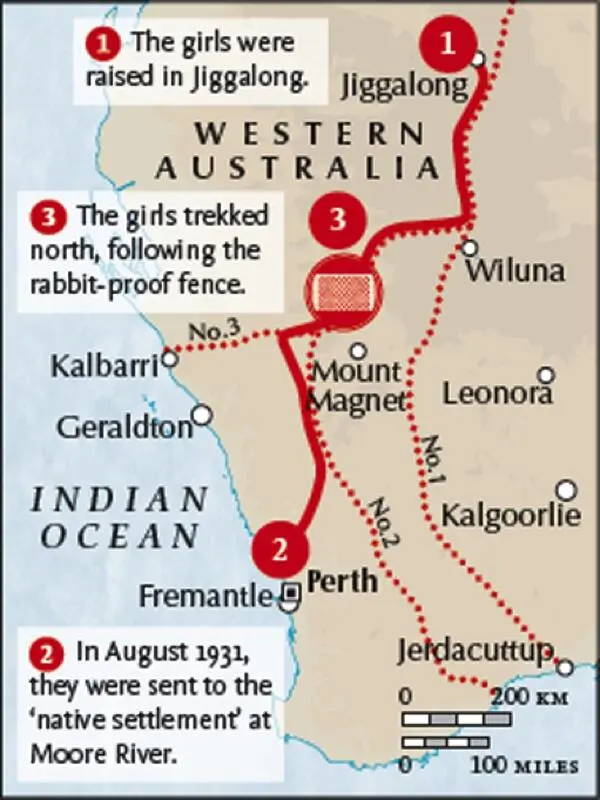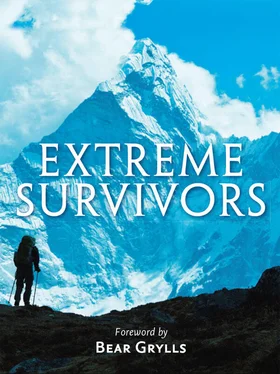The rabbit-proof fence
Rabbits are not indigenous to Australia. In 1859 an English settler in Victoria, southeast Australia released two dozen into the wild. ‘The introduction of a few rabbits could do little harm and might provide a touch of home, in addition to a spot of hunting.’ But Austin seemed to have forgotten what rabbits are good at and they were soon spreading across the continent like a plague.
Between 1901 and 1907, the government constructed one of the most ambitious wildlife containment schemes the world has ever seen. The plan was simple: cordon off the entire western side of Australia so that the rabbits couldn’t get into it. Three rabbit-proof fences crossed the country. They were one metre (3 ft) high and supported by wooden poles. No.1 Rabbit-Proof Fence ran for 1,833 km (1,139 miles) clear across the continent from Wallal Downs to Jerdacuttup. The total length of all three fences was 3,256 km (2,023 miles).
Bold though this act of segregation was, it was doomed to failure. Rabbits had already crossed west of the barrier and it was near-impossible to maintain such a structure in the harsh conditions of the Western Australian deserts, despite regular patrols by inspectors with bicycles, cars and even camels.
The fence also acts as a metaphor for another act of segregation imposed on the country by the government of the time.
The white settlers of Australia had many different attitudes to the Aboriginal population. To some they were simply an inferior race. Others believed they could be assimilated into white society and have their heritage ‘bred out’ of them. Some were tolerant and understanding and of course there were many mixed-race children. It was the most divisive issue in that period of Australian history.

From 1920 to 1930 more than 100,000 mixed-race Aboriginal children were taken from their families.

Children were relocated to be educated for a useful life as a farmhand or domestic servant. The government built harsh remand homes where Dickensian conditions were the norm. The children, many as young as three, shared prison-like dormitories with barred windows. Thin blankets gave little protection against the chill nights and the food was basic. These grim educational centres, or ‘native settlements’, were often many hundreds of miles from the place the children called home. Any children caught escaping would have their heads shaved, be beaten with a strap and sent for a spell in solitary confinement.

The food in the workhouse-like ‘native settlements’ was no better than gruel. The children had few clothes and no shoes.

Molly Craig, 14, her half-sister Daisy Kadibil, 11 and their cousin Gracie Fields, 8, arrived at the Moore River Settlement north of Perth in August 1931. They had been taken from their family in Jiggalong nearly 1,600 km (1,000 miles) away and they immediately decided to return home no matter what the consequences. Their plan was simple: they would follow the rabbit-proof fence.
The girls only had two simple dresses and two pairs of calico bloomers each. Their feet were shoeless. The only food they had was a little bread. Nevertheless, on only their second day in the settlement they hid in the dormitory and then, when no one was looking, they simply walked out into the bush. It held far fewer terrors for them than the settlement.

The girls route following the rabbit-proof fence.
The fence itself was several days’ walk away. Once they reached it they would then have several more weeks of trekking through dusty scrubland before they reached Jiggalong.
But the girls were confident that they could live off the land. Their biggest fear was getting caught by the inevitable search parties; all previous escapees had been found by Aboriginal trackers. To outfox them they would have to hide well and move fast: Molly set them a goal of covering 32 km (20 miles) a day.
‘We followed that fence, that rabbit-proof fence, all the way home from the settlement to Jiggalong. Long way, alright. We stayed in the bush hiding there for a long time.’
They made good progress at first. They hid in a rabbit warren and managed to catch, cook and eat a couple of the creatures. The weather was wet, giving them water and removing their footprints. They met two Aboriginals who gave them food and matches.
Often, when they came upon a farmhouse they simply walked up to the door and asked for help. Despite the news of their escape being widely publicised, none of the white farmers turned them in. Some gave them food and warmer clothes.
The police were on their trail, now genuinely concerned for the girls’ welfare as well as eager to return them to Moore River.
But by the third week in September the strain of life in the bush was beginning to show. Gracie, the youngest, was exhausted and the other two often had to carry her. Her legs had been slashed by thorny underbrush and become infected. After hearing from an Aboriginal woman they met that her mother had moved to nearby Wiluna, she crept aboard a train to travel there.
Molly and Daisy kept walking towards Jiggalong. They could now move faster without their younger cousin to support, but it was still brutally hard going. The rains had gone, as summer crept up on them. Every day it got hotter yet every day they were determined to cover more ground to get home quicker.
At last, in early October, the two dusty, bedraggled girls walked into Jiggalong. They had trekked for more than 1,600 km (1,000 miles) through some of the most unforgiving terrain on Earth. They were still wanted by the authorities.
But now they were home.
The families of both girls swiftly moved house to stop the authorities taking their girls again. But, perhaps aware of what a powerful tale the girls had to tell, the government called off the chase a few weeks later.
However, although the girls’ escape is a triumphant display of endurance and indomitable human spirit, their journey didn’t bring total happiness. They were still in a land where the law discriminated against them.
Gracie’s mother wasn’t in Wiluna and she was sent back to Moore River. She became a domestic servant and died in 1983.
Molly also became a domestic servant, marrying and having two daughters. But in 1940, after she was taken to Perth with appendicitis, she was sent back to Moore River by a direct government order. Amazingly, she once again walked out of the settlement and trekked back to Jiggalong. Unfortunately, she could only take one of her daughters with her; her 3-year-old girl, Doris remained in the settlement where she was brought up. Doris later wrote the book Rabbit-Proof Fence about her mother’s first journey, which was made into a film in 2002.
Читать дальше















